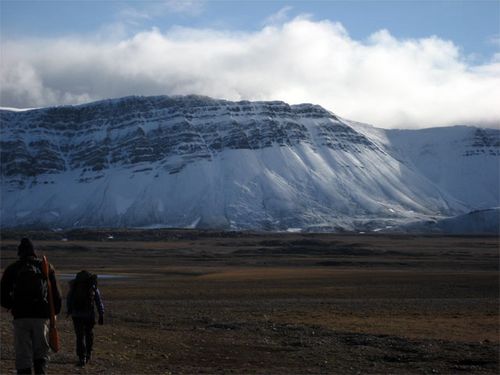We gathered in the living room of the main building at Isfjord Radio to discuss the tasks of the day and who was to be each team, the most important of which was Jesse's ice coring team. Megan, Antoine and I were to stay at the south hut to deploy a couple of items into Lake Linne, and to start shuttling supplies across the lake to the north hut and the boat docking area. Mike and Steve were to go up onto a couple of moraines near the Linne Glacier, and the balance of the Svalbard REU team went onto the Linne Glacier and continue the ice coring process and assist Kristen with the last of her glacial ablation measurements.
 Snow from the night before left us a picturesque view for our lake to the lake
Snow from the night before left us a picturesque view for our lake to the lake
Our hike out to the lake was absolutely exquisite since the snow from the night before left a coating on the western facing slopes of the ridges around our valley. It looked like confectioner's sugar sprinkled on chocolate cake; definitely dessert for the eyes! When our team got to the south end of the lake, Megan took the lead in prepping the "6 to1" sediment trap (see photo) and the intervolumeter (see photo) for deployment. This process included taking measurements along the mooring to document where the instruments will be located within the water column. In this case, both instruments will be about 1 meter above the lake bottom which is about 15 meters deep. Once it was all put together we carefully placed the sediment trap in the boat, sailed over the stream outlet, and dropped it into the water. All went fine until we saw the mooring float sitting 1 meter below the surface when it needs to be at least 1.5 to 2 meters below. The problem with that is when the lake freezes, the ice will be more than 1 meter below the surface, and when the ice melts it tends to "raft" thus pulling the mooring with it. It was easy enough for us to rectify the situation, especially with Antoine's knot-tying skills from being an accomplished sailor. Megan marked the GPS waypoints of each of the instruments, and all was set until next summer when they are removed from the lake and tell part of the story of how the sediments flow from the glacier through the stream and into the lake.
 This is called a 6 to 1 sediment trap because of the ratio of the sediment funnels to the receiving tube. This instrument will collect data for the next year.
This is called a 6 to 1 sediment trap because of the ratio of the sediment funnels to the receiving tube. This instrument will collect data for the next year.
 The intervolumenter "watches" the sediments as they fall through the the instrument, and records thte data. This data can show times of heavy sedimentation versus low sedimentation.
The intervolumenter "watches" the sediments as they fall through the the instrument, and records thte data. This data can show times of heavy sedimentation versus low sedimentation.
At the top of every hour the teams communicate with each other to make sure everything is going smoothly with each team. We tuned into some horrible news from the glacier group, the ice corer cord broke with its first pull today! The cord could have been reattached, but the screw that had to come off had a star-shaped head, and none of the tools with the team could loosen it. What to do next; it may not be possible to fix the corer and Jesse still needs his samples. The decision was to take care of all the tasks at the glacier such as downloading data and gathering instruments, and then bring the ice corer back to Isfjord Radio in hopes that Haakon had the right tool to open the motor of the corer. If the corer could be fixed, then a small team would head back to the glacier tomorrow. One can only imagine how devastating it is to have their project almost completely unravel after getting half way through the data collection process. But alas, the Svalbard REU team is optimistic that all will work out for Jesse.
The glacier team made it back to the station at about 10PM and immediately stopped to see Haakon, and fortunately he had the right tool. The cord went back onto the ice corer motor and the motor purred away at the first pull. This was a close call, but it is what can happen in field research when the project depends on so many components. The tentative plan for tomorrow is to into divide into teams to continue breaking down all the equipment, work on inventory lists, and download the balance of the data around the south end of the lake while the glacier team finishes sampling the lake.
After this long day we were treated to a bonfire by our hosts Haakon and Eva, which allowed the glacier team a chance to unwind before crashing for the evening. Tomorrow is a big day for the entire team. Stay tuned for the final events of the close of our field season.
 Our hosts, Haakon and Eva, provided us with an enjoyable bonfire.
Our hosts, Haakon and Eva, provided us with an enjoyable bonfire.
Challenge of the day: You are the leader of a team of scientists heading into the field to collect data. Formulate a 2 week plan to collect data for projects of all 5 team members. Now for a complication: the weather forecast is for rain for at least the first week of the field season. How do you manage to collect data and also keep the morale up of all the team members?

